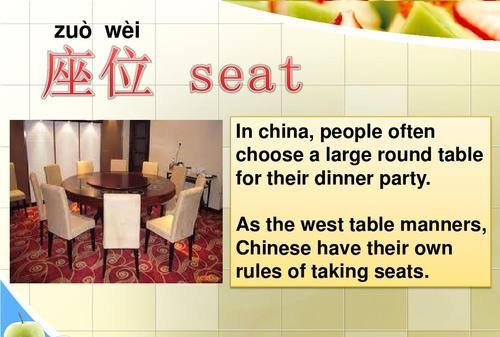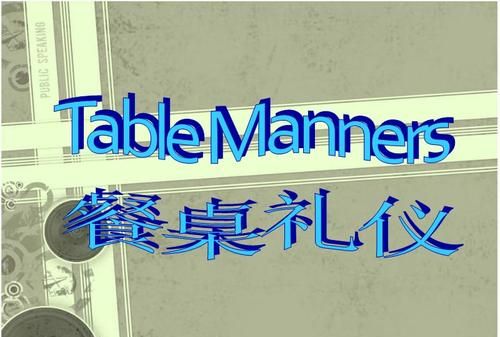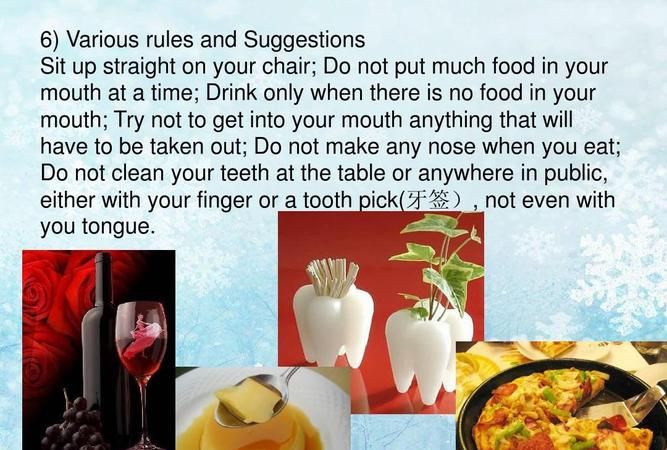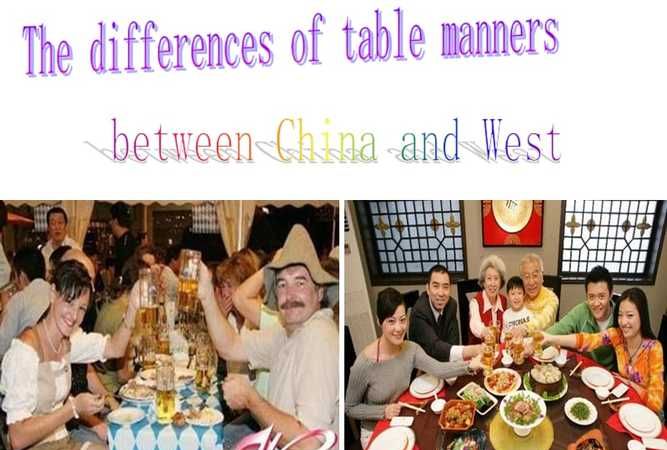本文目录
关于中国餐桌礼仪的英语作文初三
不清楚你的详细要求,这个是详细版本,可以自行缩减
Generally, Chinese table manners are more informal than the West, although there are more rules concerning interactions with other guests due to high levels of social interaction as a result of the communal style of serving.
Chopstick usage
Chopsticks should always be held correctly, i.e. between the thumb and first two fingers of the right hand.
When not in use, chopsticks must always be placed neatly on the table with two sticks lying tidily next to each other at both ends. Never point the chopsticks at another person. This amounts to insulting that person and is a major faux pas.
Never wave your chopsticks around as if they were an extension of your hand gestures.
Never bang chopsticks like drumsticks. This is akin to telling others at the table you are a beggar.
Never suck the chopsticks.
Decide what to pick up before reaching with chopsticks, instead of hovering them over or rummaging through dishes.
To keep chopsticks off the table, they can be rested horizontally on one's plate or bowl; a chopstick rest (commonly found in restaurants) can also be used.
When picking up a piece of food, never use the tips of your chopsticks to penetrate the food as with a fork; exceptions include tearing apart larger items such as vegetables. In more informal settings, smaller items or those more difficult to pick up such as cherry tomatoes or fishballs may be stabbed, but this is frowned upon by traditionalists.
Never stab chopsticks vertically into a bowl of rice, as this resembles incense sticks used at temples to pay respects to the deceased. This is considered the ultimate dinner table faux pas.
Communal chopsticks
When there are communal chopsticks, it is considered impolite to use your own chopsticks to pick up the food from the shared plate, or to eat using the communal chopsticks.
It is considered impolite to use the blunt end of one's own chopsticks to transfer food from a common dish to one's own plate or bowl; use the communal chopsticks instead.
When communal chopsticks are not provided, it is considered polite (and sanitary) to use the blunt end of one's own chopsticks to serve a guest by transferring food from the common dish to a guest's plate or bowl.
An exception to the above can usually be made in intimate settings such as at home.
Other utensils
If noodle soup is served, many consider a more elegant way to eat by picking the noodle into a serving spoon first, and eating from the spoon, rather than slurping directly from the bowl into the mouth using chopsticks.
Chinese traditionally eat rice from a small bowl held in the left hand, however by no means is this good etiquette. It is believed this is the way most people eat but not at all an indication of how it should be done. The rice bowl is raised to the mouth and the rice pushed into the mouth using the chopsticks. Some Chinese find it offensive to scoop rice from the bowl using a spoon. If rice is served on a plate, as is more common in the West, it is acceptable and more practical to eat it with a fork or spoon. The thumb must always be above the edge of the bowl.
Eating from common dishes
Pick the food on the dish that is at the top and nearest to you in distance. Never rummage through the dish or pick from the far side for your favorite food.
In general, more conservative Chinese frown upon the practice of picking more than one or two bites of food in your bowl or serving plate as if you were eating in the Western way. Most Chinese would understand the practice during infectious disease epidemics, or if the person is from the West.
If both a serving bowl - separate from rice bowl - and plate are provided, never put any food items to be eaten onto the serving plate. This rule may be relaxed for foreigners.
If a dish is soupy, pull the serving bowl near the serving dish and reduce the distance the chopsticks need carrying the food. Spilling plenty of sauce on the table is a major faux pas.
After you have picked up a food item, do not put it back in the dish.
Seniority and guests at the table
The elderly or guest(s) of honour are usually the first to start the meal.
The youngest or least senior may serve the eldest or most senior first, as part of the Confucian value of respecting seniors.
The youngest on the table addresses all of the elder members at the table before starting, perhaps telling them to please "eat rice" as a signal to help themselves.
The best food in a dish should be left to the elderly, children, or the guest of honour, even if they are one's favourite.
The eldest person present, or the guest of honour, is given a seat facing the door.
When the hostess says her food is not good enough, the guest must disagree and tell her it is one of the finest foods they have ever tasted.
Drinks
The host should always make sure everyone's cups are not empty for long. One should not pour for oneself, but if thirsty should first offer to pour for a neighbor. When your drink is being poured, you should say "thank you", and/or tap your index and middle finger on the table to show appreciation, especially when you are in Southern China, e.g. Guangdong Province. This action is evocative of bowing your head.
When people wish to clink drinks together in the form of a cheer, it is important to observe that younger members should clink the rim of their glass below the rim of an elder's to show respect.
Strong alcohol, called baijiu, is often served throughout the meal; and it is customary for the host[s]/hostess[es] to insist that guests drink to "show friendship." If the guests prefers not to drink, they may say, "I'm unable to drink, but thank you." [in Mandarin: "Wo bu neng he jiu, xie xie."] The host may continue to insist that the guests drink, and the guests may likewise continue to insist upon being "unable" to drink. The host's insistance is to show generosity. Therefore, refusal by the guests should be made with utmost politeness. Beware: If a guest drinks alcohol with a subordinate at the table, the guest will be expected [if not forced] to drink a glass of the same alcohol with each superior at that table, and possibly at other tables too—if the guest has not passed out yet.
Smoking
Smoking is an extremely prevalent habit in China, especially among men. During meals, the host will sometimes pass out cigarettes to all the men around the table. If a guest prefers not to smoke, she/he should politely refuse. In Mandarin, one could say, "我不抽烟,谢谢" (Wo bu chou yan, xie xie).
Business meals
During business meals, it is best not to eat to the point of satiation, as business and not food is the actual main purpose of the gathering.
Miscellaneous
In the past, some people tended to sit at least 1 metre (3 chi) from the dining table so they would not be literally rubbing elbows with other guests. Nowadays, this practice is rarely observed.
When eating food that contains bones, it is common for the bones be spat out onto the table next to one's plate. Spitting bones onto the floor is almost never acceptable.
Belching, smacking, and slurping are common.
By Western standards, the conversations during meals often are quite loud and animated.
Treatment of staff at restaurants is somewhat "rough," with waiters/waitresses often being advised by patrons to 快点 (kuai dian), which means "hurry up."
Talking with a full mouth and eating with the elbows on the table are both very common, and tasting food from a table guest's plate is also not uncommon.

中国餐桌礼仪英文介绍
Chinese table etiquette boils down to the following points:
1. Admission etiquette. Ask guests seated on the seats. Please elderly guests in attendance were seated next to attendance at from the left side into the chair. Admission Dongkuaizi not after. What more do not come to beep. Not to get up walk. If what happened to the owner notice.
Second, when the meal. Ask guests. Long the Dongkuaizi. Jiacai, each less. Far from the food on their own eat some. Meal not a voice. Heshang also not a sound use Kaitang I spoon a small drink and a small mouth. Pawan front-lips not drink, soup, hot cool after Zaikai. side not to drink while blowing Some people prefer to chew food to eat. extraordinary feel like work is crisp chewing food, a very clear voices. this is not etiquette demands. extraordinary and everyone is eating together, as far as possible to prevent the emergence of this phenomenon.
Third: Do not eat hiccup, other voices will not arise if there sneezing, Changming involuntarily, such as the sound, it is necessary to say "I am sorry."; I am sorry;. "Of the original cooler." Within the words . to show regret.
Fourth if guests or elders give cloth dish. Best use of chopsticks may also be the guests or elders far away from the dishes to their front, according to the habit of the Chinese nation. Dish is a one of the Top. If the same tables leadership, the elderly, the guests said. Whenever of a new dish, let them first Dongkuaizi. rotation or invite them to the first Dongkuaizi. to show their importance.
Fifth: eat the head, fishbone, bones and other objects, not Wangwaimian vomit, not onto the ground still. Slowly to get their hands Diezili, or close on their own or on Canzhuobian prepared beforehand good on paper.
Sixth: To a timely manner about the time and people just a few humorous, to reconcile the atmosphere. Guangzhaotou not eat, regardless of others, and do not devour and destroy the lavish meal, not jail sentence.
7: It is best not to the dinner table Tiya if it is to Tiya, will use napkins or sign blocked their mouths.
8: To clear the main tasks of the meal. Must be clear to do business oriented. Feelings or to the main contact. Mainly or to eat. If it is the former, when attention should be paid to the seating arrangements. Their main negotiators the seats near each other to facilitate conversations, or dredge emotion. If it is the after. need only pay attention to common-sense courtesy on the line, to focus on the appreciation of dishes,
9: The last time left. Must be expressed gratitude to the host. At the invitation of the owner or to their own homes after the house to show back
China is the etiquette of helping people, Minsishiweitian, dining How can no rules! While stressing that no attention is three meals a day, but do not know know better than OK!
1. Inviting guests to notice, Ruxi 6:00, 5:50才叫your elderly guests, it does not. 2. Hosts who looked to be late; guests should be 5-10 minutes late, and this is very considerate guests Oh, and pay attention to grasp, natural host and the guest are Huan. 3. If sit round a table, facing the door of the main blocks, or back * walls, counters; emphasize some hotels will be used napkins distinction, the highest position napkins can not casually sit Oh, unless you intend to good banquet woven?: D
4. Masters of the subject and object of the right hand side, the left hand side of the important guests; * gate facing the master, of course, is run errands entertain the Peiqia sit you. 5. Guests do not directly to the members of a la carte and calling guidance, obediently waiting for the hosts who looked to be a la carte if guests really serious taboos or hobbies, and should be gently told the hosts who looked, the owner of natural putting his interests and meet guests little or significantly requirements. 6. Hosts who looked not need points or less grasping points, or holding food dishes, such as crab, lobster legs, ribs, and so on. For a meal to the three dishes such a rule no. What can be said etiquette! 7. Not a small amount of force will not object to others drink wine without fragmentation feast! 8. On the wine servings! Foreigner likes to boast of skill, people may boast their own point-for the food, hosts who looked at carefully observed Liangcai Qi, every Cup have drinks later, when immediately drank to welcome the start. . . Like, rotating disk or right hand side indicate the subject and object moving first chopsticks. Tuirang subject and object should not be too long, oh, we stomachs are hungry, it will eat you open! Do not forget to eat the praise of some oh. 9. After one of every dish, although the waiter and owner will still go before the subject and object, but not too rigidly stick with you, if just in front of me, dead people rotating disc, I would first folder a small taste of chopsticks ! 10. Hosts who looked often to the disk will cater to the vast majority of guests; Peiqia then added services to entertain; guests can not touch the hands of disk integrity and eat meals, the two sides are also Huan you. 11. If there is no attendant at the food or chopsticks, Gongbiao, Jiacai the first time can be good, must not use their own chopsticks to pick in the session to pick, and even stirring! Not everyone is like love, like you do not mind the saliva chopsticks! Usually identified from their recent selection part. 12. Let chopsticks on the best food in their transition to a dish in only into the mouth. Phase seem to be eating is not so urgent. 13. When chewing food in the mouth, remember Bijin lips is a major event, so to speak, falling objects, Shishui spills, as well as to avoid a "Puma Puma Ji Ji" annoyance beep. 14. During the meal, or both before and after the meal, should be back straight, as far as possible but not later * chairs sit. During the meal, basically in the hands above the desktop. 15. The master of a very good appetite, and weight loss are guests, not the Fanju oh.
中国餐桌上的礼仪归结为以下几点:
一.入座的礼仪.先请客人入座上席.在请长者入座客人旁依次入座,入座时要从椅子左边进入.入座后不要动筷子.更不要弄出什么响声来.也不要起身走动.假如有什么事要向主人打招呼.
第二,进餐时.先请客人.长着动筷子.夹菜时每次少一些.离自己远的菜就少吃一些.吃饭时不要出声音.喝汤时也不要出声响,喝汤用汤匙一小口一小口地喝.不宜把碗端到嘴边喝,汤太热时凉了以后再喝.不要一边吹一边喝.有的人吃饭喜欢用咀嚼食物.非凡是使劲咀嚼脆食物,发出很清楚的声音来.这种做法是不合礼仪要求的.非凡是和众人一起进餐时,就要尽量防止出现这种现象.
第三:进餐时不要打嗝,也不要出现其他声音,假如出现打喷嚏,肠鸣等不由自主的声响时,就要说一声"真不好意思".;对不起;."请原凉".之内的话.以示歉意.
第四;假如要给客人或长辈布菜.最好用公筷.也可以把离客人或长辈远的菜肴送到他们跟前,按我们中华民族的习惯.菜是一个一个往上端的.假如同桌有领导,老人,客人的话.每当上来一个新菜时就请他们先动筷子.或着轮流请他们先动筷子.以表示对他们的重视.
第五:吃到鱼头,鱼刺,骨头等物时,不要往外面吐,也不要往地上仍.要慢慢用手拿到自己的碟子里,或放在紧靠自己餐桌边或放在事先预备好的纸上.
第六:要适时地抽空和左右的人聊几句风趣的话,以调和气氛.不要光着头吃饭,不管别人,也不要狼吞虎咽地大吃一顿,更不要贪杯.
第七:最好不要在餐桌上剔牙.假如要剔牙时,就要用餐巾或手挡住自己的嘴巴.
第八:要明确此次进餐的主要任务.要明确以谈生意为主.还是以联络感情为主.或是以吃饭为主.假如是前着,在安排座位时就要注重.把主要谈判人的座位相互靠近便于交谈或疏通情感.假如是后着.只需要注重一下常识性的礼节就行了,把重点放在欣赏菜肴上,
第九:最后离席时.必须向主人表示感谢.或者就此时邀请主人以后到自己家做客,以示回
中国人乃礼仪之帮,民以食为天,用餐岂能没有规矩!虽然说讲不讲究都是一日三餐,但是知道总比不知道好吧!
1。请客要早通知,6:00入席,老人家你5:50才叫客人来,不对吧。2。主人家不能迟到;客人应当迟到5-10分钟,这是非常体贴的客人哦,注重把握,自然宾主皆欢。3。要是坐圆桌子,对着大门的是主座,或是背*墙、柜台的;讲究些的饭店,会用餐巾予以区分,餐巾最高大的位置不能随便坐哦,除非你打算好请客喽:D
4。主人右手边的是主客,左手边的是次重要的客人;*门边面对主人的,自然是跑腿招呼的陪客坐的啦。5。做客人的不能直接向点菜员吆喝指点,应该乖乖坐等主人家点菜;假如客人确实有严重的忌口或爱好,应当轻轻告诉主人家,主人自然要替他做主,满足客人小小或大大的要求。6。主人家,不点或少点需要用手抓或握着吃的菜,比如蟹、龙虾腿、排骨等等。一顿饭来上三个这样的菜就没治了。还有什么礼仪可讲!7。不勉强也不反对别人少量饮酒,无酒不成宴嘛!8。上酒水上菜了!老外喜欢自夸手艺,国人可不作兴吹嘘自己点的菜,主人家细心观察凉菜上齐、每位杯中都有酒水后,当立即举杯,欢迎开始。。。之类的,转动圆盘或是示意右手边的主客动第一筷。主客可别推让太久哦,大家肚子都饿了,就等你开吃了!吃了的别忘了赞美一下哦。9。之后的每道菜一上来,虽然服务员与主人还是会转到主客面前,但并不用太拘泥啦,假如正好在我面前,又没人转动圆盘,我也会先夹一小筷子尝尝的!10。主人家要经常转圆盘,照顾到绝大部分客人;陪客则补充招呼服务一下;客人的手能不碰圆盘而吃完整餐,则宾主又皆欢啦。11。假如没有服务员分菜或是公筷、公勺,夹菜的时候可要先看好,切不可用自己的筷子在盘中挑来拣去,甚至搅拌!不是每个人都像爱人一样不介意你筷子上的口水的!通常看准了拣距离自己最近的那部分。12。最好让筷子上的食物在自己的接碟中过渡一下,才送入口中。可以使吃相看起来不是那么急切。13。食物在口中咀嚼时,切记的大事就是闭紧双唇,以免说话、物体掉落、汁水外溢,以及免得发出"骠叽骠叽"的倒胃口声响。14。无论是用餐期间或用餐前后,都应当背部挺直,尽量往后坐椅子而不*。用餐期间,基本上双手都在桌面以上。15。一个太好胃口的主人,和正在减肥的客人,不适宜这样的饭局哦。

中国餐桌礼仪英语10句简单
1.让客人和长辈先吃每一道菜
let the elder people and the customer eat first
2.不要用筷子敲碗
don't use the chopsticks hit the bowl
3.不要将手伸到饭桌对面夹菜
don't reach to get the food on the opposite side
4.等大家到齐了,才开始吃
don't eat until everyone is there
5.为主人的长寿、健康、成功干杯
wish for the people who host the dinner
久仰,久仰!
I have long been looking forward to meeting you.
I have long desired to meet you.
久违了。
I haven’t seen you for ages/for a long time.
It’s been such a long time since we met last time.
久闻大名。
I’ve heard a lot about you.
这次由我负责全程陪同你们。
I will be with you for the entire visit/trip.
欢迎你到中国来。一路上辛苦了! / 一路上还好吧?
Welcome to China.I hope you’ve had a good flight.
或I hope you enjoyed your flight. / How was your journey?
谢谢你专程来接我。
Thank you very much for coming all the way to meet me.
您贵姓?/您怎么称呼?
May I know your name,please?
很高兴见到你。您怎么称呼7
Glad/Pleased to meet you,Misterr…?(可以用拖长问话的办法来询问对方的姓名)
中国有句古话说:“有朋自远方来不亦乐乎?”
There’s an old saying in Chinese which goes: “Isn’t it a great pleasure/joy to have friends coming from afar?
As a Chinese saying goes, “Nothing is more delightful than meeting friends from far away.”
这是给您准备的日程安排.我们简单过一遍吧。如果你有什么特殊要求.也可以告诉我。
This is the tentative itinerary/schedule I have prepared for you.Let’s go through it
together.If there is any special request,just let me know.
如果有什么需要帮忙的.尽管说。
If you need anything,don’t hesitate to ask.
Just let me know if you need anything.
我们安排你住在城里的……酒店.离我们公司开车要走40分钟。
We’ve arranged for you to stay in…Hotel,which is in the downtown area,about 40- minute drive from our company.
我们也有宾馆,不过条件不如酒店。离单位倒是很近.走路就可以到。
We have our own guest house,but there is no comparison between the two, only the guest house is within walking distance of the workplace.
除了正式会谈以外.我们也为大家安排了一些游览活动。
In addition to official meetings,we have also arranged some sightseeing.
我期待着您的再次来访。
I’m looking forward to your visit again.
代我向……问好。
Remember me to… / Say hello to…for me.
不用谢,这是我们应该做的。
Don’t mention it. It’s my pleasure.
欢迎再来!
Do come again.

中国餐桌礼仪英语10句带翻译
China Dining Custom
Table Manners
The main difference between Chinese and western eating habits is that unlike the West, where everyone has their own plate of food, in China the dishes are placed on the table and everybody shares. If you are being treated by a Chinese host, be prepared for a ton of food. Chinese are very proud of their culture of cuisine and will do their best to show their hospitality.
And sometimes the Chinese host use their chopsticks to put food in your bowl or plate. This is a sign of politeness. The appropriate thing to do would be to eat the whatever-it-is and say how yummy it is. If you feel uncomfortable with this, you can just say a polite thank you and leave the food there.
Eating No-no's
Don't stick your chopsticks upright in the rice bowl.Instead,lay them on your dish. The reason for this is that when somebody dies,the shrine to them contains a bowl of sand or rice with two sticks of incense stuck upright in it. So if you stick your chopsticks in the rice bowl, it looks like this shrine and is equivalent to wishing death upon a person at the table!
Make sure the spout of the teapot is not facing anyone. It is impolite to set the teapot down where the spout is facing towards somebody. The spout should always be directed to where nobody is sitting, usually just outward from the table.
Don't tap on your bowl with your chopsticks.Beggars tap on their bowls, so this is not polite.Also, when the food is coming too slow in a restarant, people will tap their bowls. If you are in someone's home,it is like insulting the cook.
Drinking
Gan Bei! (Cheers! “Gan Bei” literally means “dry [the] glass”) Besides beer, the official Chinese alcoholic beverage is Bai Jiu,high-proof Chinese liquor made from assorted grains. There are varying degrees of Bai Jiu. The Beijing favorite is called Er Guo Tou, which is a whopping 56% alcohol. More expensive are Maotai and Wuliangye

以上就是关于中国餐桌礼仪20条英语 ,关于中国餐桌礼仪的英语作文初三的全部内容,以及中国餐桌礼仪20条英语 的相关内容,希望能够帮到您。
